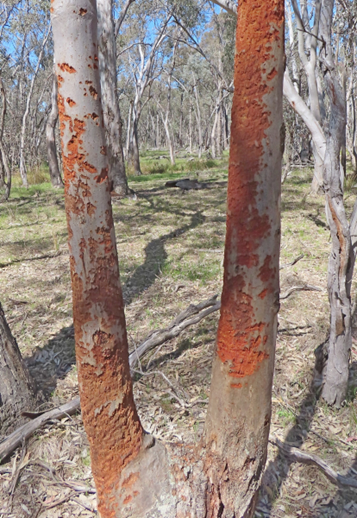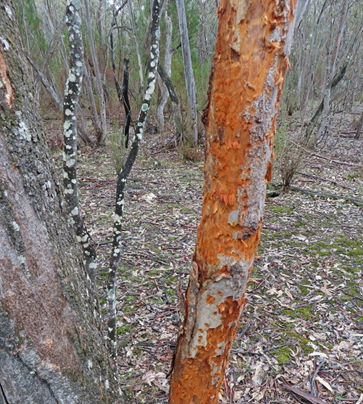By Mick Webster, Friends of Chiltern Mt Pilot National Park
If you ask anyone what koalas eat, they’ll probably say ‘eucalyptus leaves’, and my ‘Mammals of Victoria’ (Menkhorst) says just that with no mention of anything else. But it’s now become apparent that the koalas in the Park are broadening their diet to include eucalyptus bark. I was first told about this several months ago by a friend in Beechworth who said there were many trees that had been chewed by koalas in the Pilot section of Chiltern Mount Pilot National Park.
When I had a look along Wardens Rd, I found many more and since then I’ve made a rule – ‘wherever there are Eucalyptus blakelyis (Blakelys Redgum) growing in the swampy areas below the ridges, there will be some evidence of koala bark chewing’. Koalas will chew the top millimetre or so of the bark of a selected tree from ground level up to at least 5 metres.
We know it’s being chewed, not shredded by cockies, as there are very few chips on the ground (usually none), and often quite a bit of koala poo around the tree.
What’s the scientific evidence for this behaviour? The paper referenced below provides some answers. Researchers from ANU studied this in the Monaro and concluded in 2017 that the koalas are selecting specific trees. In the Monaro they were E. mannifera (Brittle Gum – similar to blakelyi as it has a smooth gum-type bark) for the mineral sodium in the bark.
They compared the sodium (Na) (and other mineral elements) in selected trees and found that chewed trees have up to 10 times as much Na as non-chewed ones, and the bark has up to 10 times as much Na as the leaves which are still the koalas main diet. Sodium, apart from giving humans heart attacks and strokes if over-consumed, is a vital element in any mammal’s diet, ensuring nerve health and blood volume and balance. There was no variation in any other mineral nutrient between chewed and non-chewed trees. Strangely the Monaro koalas showed no interest in salt licks the researchers put out!
Is this new behaviour? We don’t know, maybe we’re just noticing it now. Certainly I can find almost no reference to it happening anywhere in Victoria in any reference work, or online. The fact that trees have been found chewed in at least six sites many kilometres apart, in both the Pilot and Chiltern sections of the Park, indicates it’s not an isolated instance – koalas must feel a lack of sodium and somehow know how to get it from bark. For those interested in seeing a chewed tree there is one next to Pine Gap Rd, about 50m North of Honeysuckle Creek Rd.
Now we know they chew blakelyis I’m going to have a look at the manniferas along Old Coach Rd, and around Beechworth!
And I’d be interested to know of any other cases people find.
Mick Webster websterm@netc.net.au
Reference: https://academic.oup.com/jmammal/article-abstract/98/4/1185/3795753


